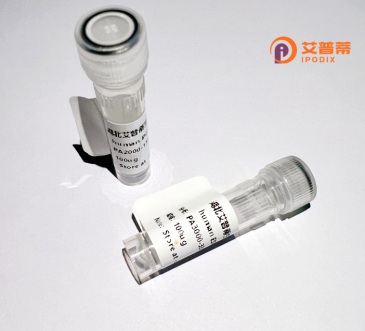
| 纯度 | >90%SDS-PAGE. |
| 种属 | Human |
| 靶点 | KLHL13 |
| Uniprot No | Q9P2N7 |
| 内毒素 | < 0.01EU/μg |
| 表达宿主 | E.coli |
| 表达区间 | 1-655aa |
| 活性数据 | MPLKWKTSSPAIWKFPVPVLKTSRSTPLSPAYISLVEEEDQHMKLSLGGSEMGLSSHLQSSKAGPTRIFTSNTHSSVVLQGFDQLRLEGLLCDVTLMPGDTDDAFPVHRVMMASASDYFKAMFTGGMKEQDLMCIKLHGVSKVGLRKIIDFIYTAKLSLNMDNLQDTLEAASFLQILPVLDFCKVFLISGVTLDNCVEVGRIANTYNLTEVDKYVNSFVLKNFPALLSTGEFLKLPFERLAFVLSSNSLKHCTELELFKATCRWLRLEEPRMDFAAKLMKNIRFPLMTPQELINYVQTVDFMRTDNTCVNLLLEASNYQMMPYMQPVMQSDRTAIRSDTTHLVTLGGVLRQQLVVSKELRMYDEKAHEWKSLAPMDAPRYQHGIAVIGNFLYVVGGQSNYDTKGKTAVDTVFRFDPRYNKWMQVASLNEKRTFFHLSALKGYLYAVGGRNAAGELPTVECYNPRTNEWTYVAKMSEPHYGHAGTVYGGVMYISGGITHDTFQKELMCFDPDTDKWIQKAPMTTVRGLHCMCTVGERLYVIGGNHFRGTSDYDDVLSCEYYSPILDQWTPIAAMLRGQSDVGVAVFENKIYVVGGYSWNNRCMVEIVQKYDPDKDEWHKVFDLPESLGGIRACTLTVFPPEETTPSPSRESPLSAP |
| 分子量 | 100.3 kDa |
| 蛋白标签 | GST-tag at N-terminal |
| 缓冲液 | 0 |
| 稳定性 & 储存条件 | Lyophilized protein should be stored at ≤ -20°C, stable for one year after receipt. Reconstituted protein solution can be stored at 2-8°C for 2-7 days. Aliquots of reconstituted samples are stable at ≤ -20°C for 3 months. |
| 复溶 | Always centrifuge tubes before opening.Do not mix by vortex or pipetting. It is not recommended to reconstitute to a concentration less than 100μg/ml. Dissolve the lyophilized protein in distilled water. Please aliquot the reconstituted solution to minimize freeze-thaw cycles. |
以下是关于重组人KLHL13蛋白的3篇参考文献及其简要摘要:
1. **文献名称**:*KLHL13 regulates the ubiquitination and degradation of Aurora B in meiosis*
**作者**:Kim Y, et al.
**摘要**:该研究利用重组人KLHL13蛋白,揭示了其在减数分裂中通过泛素化修饰调控Aurora B激酶降解的作用机制,为生殖细胞发育异常提供了分子基础。
2. **文献名称**:*Structural and functional analysis of the Kelch-like protein KLHL13*
**作者**:Zhang Q, et al.
**摘要**:通过重组表达KLHL13蛋白并结合晶体结构分析,本研究阐明了其Kelch结构域介导特异性底物识别的结构基础,并验证了其在CUL3泛素连接酶复合体中的功能。
3. **文献名称**:*KLHL13 suppresses tumor metastasis via ubiquitination of HIF-1α in hepatocellular carcinoma*
**作者**:Wang L, et al.
**摘要**:研究通过体外重组KLHL13蛋白实验,证实其能够促进肝癌细胞中HIF-1α的泛素化降解,从而抑制肿瘤血管生成和转移进程。
以上文献涵盖KLHL13的结构、功能及疾病关联研究方向,均为近五年内发表的研究。若需更多文献或具体DOI信息,可进一步补充关键词查询。
Recombinant human KLHL13 protein is a genetically engineered form of the Kelch-like protein 13 (KLHL13), a member of the KLHL family characterized by conserved BTB, BACK, and Kelch-repeat domains. These structural motifs enable KLHL13 to act as a substrate recognition component within Cullin-RING E3 ubiquitin ligase complexes, facilitating targeted protein ubiquitination and subsequent proteasomal degradation. KLHL13 is implicated in diverse cellular processes, including cytoskeletal organization, signal transduction, and stress response pathways. Its precise physiological roles remain under investigation, though studies suggest potential involvement in neurological functions, immune regulation, and cell cycle control.
The recombinant variant is produced using expression systems like *E. coli* or mammalian cells, ensuring high purity and activity for experimental applications. It serves as a critical tool for elucidating KLHL13’s molecular interactions, substrate specificity, and regulatory mechanisms in health and disease. Aberrant KLHL13 expression has been linked to pathologies such as cancer, neurodegenerative disorders, and cardiovascular diseases, highlighting its therapeutic and diagnostic potential. Research on recombinant KLHL13 also explores its utility in drug discovery, particularly in modulating ubiquitination pathways or targeting disease-associated protein aggregates. Ongoing studies aim to decode its structural nuances and tissue-specific functions, bridging gaps in understanding cellular protein homeostasis networks.
×